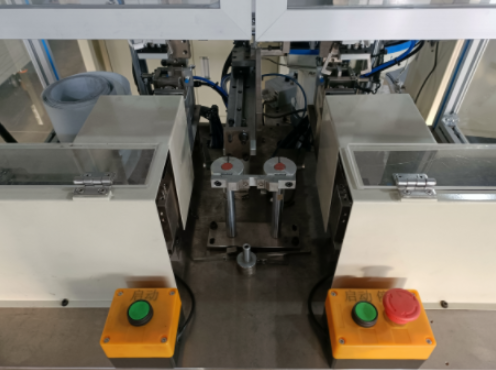How to Troubleshoot and Troubleshoot DC Motor Motor Semi-Automatic Spring Brush Machine?
DC motor motor semi-automatic spring brush machine fault analysis and troubleshooting:
First, fault analysis steps
1, observe the fault phenomenon
Motor does not run: first check whether the power supply is connected, observe whether the power indicator light is on. If the power supply is normal, check whether the motor has signs of jamming, such as turning the motor shaft by hand whether it can rotate flexibly. At the same time, check whether the control unit has a fault message.
The motor is running but the brushing is not normal: Observe the movement status of the brush head to see if it is stuck, shaking or not working at all. Check whether the contact between the brush head and the object to be brushed is good, and whether the transmission parts work normally.
Motor abnormal heat: pay attention to the temperature of the motor shell, if it feels abnormally hot, check whether the load of the motor is too heavy, whether the ventilation is good, and whether there are short circuits and other electrical faults inside the motor.
Brush sparking: Observe the contact area between the brush and the commutator to see the size and frequency of the spark. Slight sparking may be normal, but if the sparking is large and persistent, it may be due to worn brushes, uneven commutator surface, or improper spring pressure.

2、Collect equipment information
Equipment operation history: to understand the operation of the equipment before the failure, such as whether a long period of continuous operation, whether there is a record of overload operation, whether the recent parameter adjustment or equipment maintenance.
Frequency of failure: Determine whether the failure is the first time or a frequent occurrence. If it occurs frequently, record the time interval between each failure, the working environment and other information, which helps to determine whether it is an occasional failure or a systematic failure.
Equipment use environment: Check the operating environment of the equipment, including temperature, humidity, and dust conditions. For example, in a humid environment, the electrical components may be damaged by moisture; in a dusty environment, the heat dissipation and electrical contact of the motor may be affected.
Second, common faults and troubleshooting methods
1、Electrical system failure
Power problem
Failure phenomenon: the motor does not run at all, the power indicator does not light.
Cause analysis: may be the power plug is not plugged, power cord damage, blown fuse or power switch failure.
Troubleshooting method: First check whether the power plug is firmly inserted into the socket, and then check whether the power cord is broken. If the power cord is normal, check whether the fuse is blown, if so, replace the fuse with the same specification. If the fuse is normal, check whether the power switch works normally, if so, replace the power switch.
Motor winding failure
Failure phenomenon: the motor runs weakly, heats up seriously or makes abnormal noises.
Cause analysis: The motor winding may be short-circuited, disconnected or damaged insulation. This may be due to long-term overload operation, motor moisture or manufacturing defects and other reasons.
Remedy: Use the insulation resistance meter to check the insulation resistance of the motor winding, if the insulation resistance is too low, it means that the insulation is damaged and the motor needs to be repaired or replaced. For the case of short-circuit or disconnection of the windings, it is necessary for professionals to use professional tools (such as a multimeter) to carry out testing to determine the point of failure, and then rewind the windings or replace the motor.
Brush and commutator failure
Failure phenomenon: Brushes sparking, unstable motor operation or speed drop.
Cause analysis: excessive wear of brushes, insufficient pressure on brush springs, or uneven surface of commutator, dirt, etc. may lead to such failures.
Remedy: Check the degree of wear of the brushes, if the length of the brushes is less than the specified value, replace the brushes. Check the pressure of the brush spring and replace the spring if necessary to maintain good contact pressure between the brush and the commutator. For the dirt on the surface of the commutator, wipe it with a clean cloth; if the surface is uneven, use fine sandpaper to gently polish it so that the surface is smooth.
2、Mechanical system failure
Transmission components failure
Failure phenomenon: brush head movement abnormalities, such as jamming, shaking or no movement, while the motor runs normally.
Reason analysis: if the belt drive, the belt may be slack, wear and tear or slip; if the gear drive, may be gear wear, foreign objects between the teeth or gear mesh bad.
Remedy: For belt drive, adjust the tension of the belt, if the belt is badly worn, replace the belt. For gear drive, clean the foreign matter between the teeth, check the wear of the gear, if the wear is serious, replace the gear. At the same time, check the meshing of the gears, adjust the installation position of the gears to ensure good meshing.
Brush head and spring failure
Failure phenomenon: The brush head is excessively worn and cannot be brushed properly, or the spring loses its elasticity, resulting in poor contact between the brushes and the commutator.
Cause analysis: The brush head will naturally wear out with long-term use, while the spring may lose its elasticity due to prolonged compression or fatigue.
Remedy: Replace the worn brush head, and for the spring that has lost its elasticity, replace it with a new one, and adjust the pressure of the spring so that it meets the requirements of the equipment.
3、Control system failure
Control unit hardware failure
Failure phenomenon: the motor can not run in accordance with the set parameters, such as speed out of control, brush time can not be controlled, etc., or the control unit does not respond.
Cause analysis: it may be the circuit board of the control unit is damaged, chip failure or loose connection lines.
Remedy: Check whether the connection line of the control unit is firm, and re-plug the connection line. If the line is normal, may be the circuit board or chip failure, which requires professional personnel to test and repair, may need to replace the damaged circuit board or chip.
Control software failure
Failure phenomenon: the control unit displays an error message, parameter settings can not be saved or abnormal operation of the device.
Cause analysis: may be the software program error, software and hardware incompatibility or software parameter setting error.
Troubleshooting: Try to restart the control unit to see if the fault disappears. If the fault still exists, check whether the software version is a new version of the software, if any update, timely software updates. Recheck the software parameter settings to ensure that the parameters meet the requirements of the device. If the software is not compatible with the hardware, contact the equipment manufacturer to obtain a compatible software version.
※ If the above ways and means still can not solve the equipment failure, please contact the technical specialist of Xinhui Electromechanical Equipment Co.







